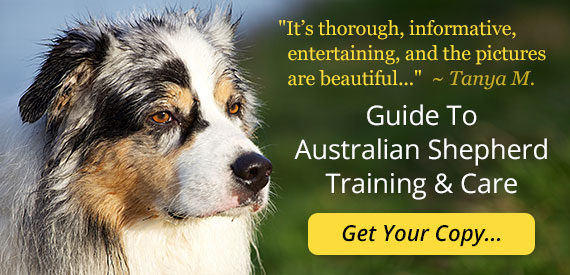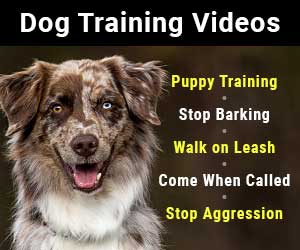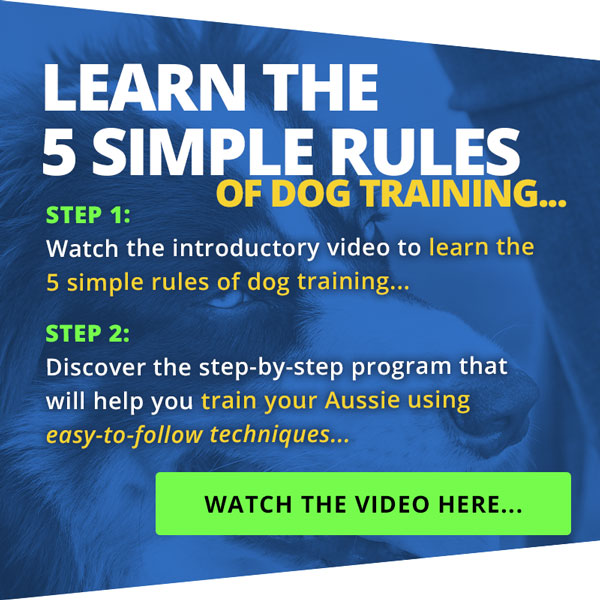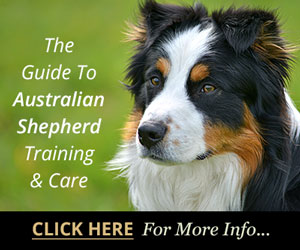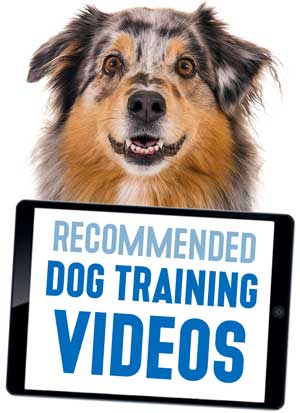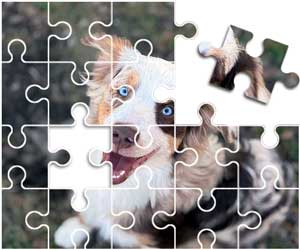
Use Clicker Dog Training to Train Your Australian Shepherd With Positive Reinforcement
Clicker training is a style of training based on the work of B. F. Skinner, Bob and Marian Bailey, and Karen Pryor. Karen Pryor coined the phrase ‘clicker training’ when she was working with dolphins in the 60s (as chronicled in her excellent book, Lads Before the Wind). In clicker training a sound, usually a clicker, is used to mark a desired event. Thus the sound of the clicker is called an ‘event marker’. The click is always followed by a treat, so that the animal associates the event with something rewarding. (This is a form of Operant Conditioning.) Research has shown that rewarded (reinforced) behaviors are likely to increase.
A classic example is that of teaching the sit. Each time the dog sits he gets a click, followed by a treat. The dog will sit more and more often.
Clicker dog training is an ideal way to communicate with your dog. A partnership is created between you and your dog based on love and respect. The click is a neutral tone (neither cheerful nor angry, unlike the human voice), and will only be associated with good things. The click can instantly communicate to the dog that it has done something desirable.
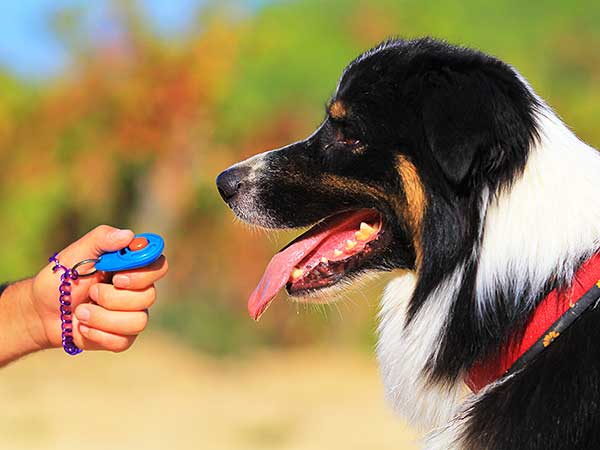
melounix / stock.adobe.com
Clicker dog training is a proven method that uses positive reinforcement that can help you train your Aussie.
Clicker Dog Training Uses Operant Conditioning Principles
Reinforcement, Punishment, Extinction, and Aversives
These are terms used in Operant Conditioning. Reinforcement and Punishment can be divided into four categories.
It is imperative to remember that + and – are mathematical terms, not moral judgments!
- Positive reinforcement (R+): This is where something is added in order to increase a behavior.
Ex: you give your dog a treat to reinforce the sit.
- Negative reinforcement (R-): Something is removed in order to increase a behavior. Ex: you
stop pinching the dog’s ear when it opens its mouth to
take a dumb bell. (NOT approved
of in clicker dog training!)
- Positive punishment (P+): Something is added to decrease a behavior. Ex: hitting a dog
to get it to stop jumping up. (NOT
an approved training technique!)
- Negative punishment (P-): Something is removed to decrease a behavior. Ex: walking away
when your dog jumps up on you, thus removing the attention he
desires. This is far more desirable than positive punishment,
but still must be used carefully.
- Extinction: Weakening a behavior
by not reinforcing it. Instead of petting your dog when he jumps
on you, you walk away (P-). Eventually the dog will stop jumping
on you (extinction).
- Aversives: Aversives are something an animal will work to avoid. Ex: collar pops, shocks from an electric collar, hitting, yelling, shaking the dog by the scruff, ‘alpha rolls’. None of these are acceptable forms of training in the field of clicker dog training. (Technically P- is a form of aversive, because something the dog wants has been taken away. However, P- used sparingly and judiciously, can be effective.)
Clicker Dog Training Basics: Charging the Clicker
The key to clicker dog training is helping your dog associate the sound of the clicker with something rewarding. These associations can be very powerful. (Ex: Someone walks past smelling of rose perfume. You are immediately transported back to childhood and visits to Gramma’s house, because she used rose perfume. Not just memories, but the emotions that go with them come flooding back.)
The easiest way to do this is to just start clicking. With the clicker in your hand, put your hand in a pocket or behind your back. This way the sound shouldn’t startle the dog. Click, and give your dog a delicious, pea sized treat. Keep doing this, moving your clicker hand to different positions. (This way the dog doesn’t just associate rewards with the sound coming from a particular location.) After about 15-20 clicks (it varies from dog to dog), the dog will perk up when it hears the click, and start looking around for the treat. Hooray! The dog has now made the association.
If your dog is afraid of the sound of the clicker you can soften the tone by putting layers of tape across the dimple on the clicker. Gradually remove the tape, one layer at a time, so the dog can adjust to the tone.
No, you don’t have to spend the rest of your life carrying around a clicker and a bag of treats. Once the dog has figured out the desired behavior, and is performing it reliably, you gradually start weaning off the clicker. Every click is STILL followed by a treat, you just click less often, slowly decreasing the frequency until you aren’t clicking at all. (If you think about it, you don’t need to have someone come over and cheer every time you write your name legibly. The reinforcement was valuable when you were learning it, but once you’ve mastered the skill it’s no longer necessary.)
NOTE: Remember to praise your dog! Clicking and treating (C/T) doesn’t mean we refrain from verbal praise.
Clicker Dog Training Tips
If your dog isn’t interested in the treats there could be several reasons.
- Your training area is too distracting. Make
sure you’re in a quiet location, such as a room with no
T.V. blaring, kids playing, etc. (The bath room is ideal!)
- Your dog isn’t hungry. Schedule your
training sessions a few hours before or after mealtime, when
the stomach is empty.
- Your treats aren’t appealing. Be sure you’re using a treat the dog likes. Different dogs are motivated by different foods. Try Cheerios, hot dogs, diced meat, diced cheese, a premium kibble other than his usual food, premium cat food (as an occasional treat), anything that excites your dog!
More Clicker Dog Training Tips
If your dog is too enthusiastic about taking treats from your hand, don’t despair.
- With young dogs, say ‘yikes’ or
‘ouch’, in a high pitched tone (so you sound like
a puppy), and then pull your hand away. Then go away for a minute
or so.
- Another trick is to make a fist around the
treat. As long as the dog chews at your hand, it doesn’t
get the treat. Once it stops and backs up, open your hand and
let the dog have the treat. If your dog is a real shark, you
can wear a glove during the process.
- Lastly, try giving the treats from a metal spoon. Dogs don’t like the feeling of biting metal. With each treat, move your hand closer to the bowl of the spoon, until your fingers are on the bowl. Then switch to using your hand.
For clicker dog training classes in Imperial Beach or San Diego county area contact Lynn Whinery at Bonza Canine Education.
Have Dog Training Questions?
Check out these introductory dog training videos...
I want my dog to stop being aggressive.
I want some help training my new puppy.
I want my dog to stop barking at everything.
Get Australian Shepherd Info, Website Updates, Special Offers, and Cartoons...
FREE GIFT
You'll also receive a free copy of the ebook
My Everyday Dog Training Tools
by professional dog trainer Daniel Abdelnoor, "Doggy Dan"

